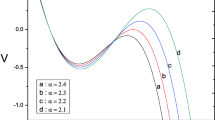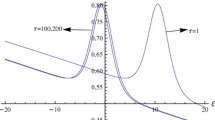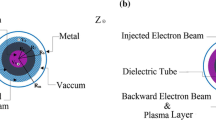Abstract
Bounded plasma occur in waveguide of nanodevices with dielectric boundaries and the dimension of nanodevices control the frequency of oscillation and particle acceleration. A system with cylindrical bounded quantum plasma is used to study the electrostatic wave instability in the presence of magnetic field. Bohm potential, exchange-correlation potential and Fermi pressure significantly affect the characteristic frequency of oscillation of particle in bounded plasma. Using quantum hydrodynamic model, basic equations of cylindrical bounded quantum plasma are constructed and linearized under the effect of ionization rate. Dispersion relation for growing waves is obtained, which shows dependence on ionization rate, magnetic field, number density, wave vector and geometry of cylindrical waveguide. We investigated that growth rate increases with magnetic field, ionization rate, number density and poles of Bessel’s function, whereas it decreases with wave vector and radius of waveguide. The present investigation is performed on the basis of numerical parameters of astrophysical plasma.







Similar content being viewed by others
References
Aliev Y. M., Schluter H., Shivarova A. 2000, Guided-Wave-Produced Plasma, Springer
Aslanyan V., Tallents G. J. 2015, Phys. Rev. E, 91, 063106
Ayesha R., Rasheed A., Ali M., Zeba I., Jamil M. 2021, Arb. J. Sci. Eng., 46, 1
Bandyopadhyay D. 2017 J. Astrophys. Astron., 38, 37
Brey L., Dempsey J., Johnson N. F., Halperin B. I. 1990, Phys. Rev. B, 42, 1240
Choudhury S. R., Kaw P. K. 1989, Phys. Plasmas, 1, 1646
Craighead H. G. 2000, Science, 290, 1532
Gardner C. L. 1994, SIAM J. Appl. Math., 54, 409
Gopal K., Gupta D. N., Jain A., Hur M. S., Suk H. 2021, Curr. Appl. Phys., 25, 82
Gopal K., Gupta D. N., Kim Y. K., Hur M. S., Suk H. 2016, J. Appl. Phys., 119, 123101
Haas F. 2005, Phys. Plasmas, 12, 062117
Haas F. 2011, Quantum Plasma Physics: An Hydrodynamic Approach, Encyclopedia of Plasma Technology, Springer
Hansen W. W. 1938, J. Appl. Phys., 9, 654
Hong W. P., Jung Y. D. 2016, Phys. Plasmas, 23, 034503
Hur M. S., Gupta D. N., Suk H. 2008, Phys. Lett. A, 372, 2684
James C., Long J., Manning D. 2018, Sci. Rep., 9, 3143
Jamil M., Ayesha R., Rasheed A., Iqbal Z., Asif M. 2018, Phys. Plasmas, 25, 062124
Jamil M., Ilyas M., Rasheed A., et al. 2020, Phys. Scr., 95, 115601
Jung Y. D., Hong W. P. 2013, Phys. Lett. A, 377, 560
Khorashadizadeh S. M., Boroujeni S. T., Rastbood E., Niknam A. R. 2012, Phys. Plasmas, 19, 032109
Lee M. J., Jung Y. D. 2017, Phys. Lett. A, 381, 636
Li C., Wu Z., Yang W., Chu P. K. 2014, Phys. Plasmas, 21, 072114
Ma Y. T., Mao S. H., Xue J. K. 2011, Phys. Plasmas, 18, 102108
Malik H. K., Singh S. 2013, Phys. Plasmas, 20, 052115
Manfredi G., Haas F. 2001, Phys. Rev. B, 64, 075316
Metcalfe T. S. 2005, J. Astrophys. Astron., 26, 273
Mohamed B. F. 2010, Phys. Scr., 82, 065502
Niknam A. R., Boroujeni S. T., Khorashadizadeh S. M. 2013, Phys. Plasmas, 20, 122106
Petrovia D., Vranjes J., Poedts S. 2005, Phys. Plasmas, 12, 112103
Prajapati R. P., Chhajlani R. K. 2010, Phys. Scr., 82, 55003
Prajapati R. P., Chhajlani R. K. 2013, Astrophys. Space Sci., 344, 371
Schramm S., Dexheimer V., Mukherjee A., Steinheimer J. 2018, J. Astrophys. Astron., 39, 42
Shahmansouri M., Mahmodi M. M. 2017, Phys. Plasmas, 24, 102107
Sharma P. 2018, Phys. Lett. A, 382, 1796
Sharma P., Jain S., Prajapati R. P. 2016, IEEE Transactions on Plasma Science, 44, 862
Shoucr M. M. 1970, Nucl. Fusion, 10, 431
Shukla P. K., Eliasson B. 2011, Rev. Mod. Phys., 83, 885
Singh S., Malik H. K., Nishida Y. 2013, Phys. Plasmas, 20, 102109
Souza de R. S., Opher R. 2010, Astrophys. Space Sci., 330, 267
Stupka A. A. 2008, J. Astrophys. Astron., 29, 379
Subramaniam C., Yamada T., Kobashi K., et al. 2013, Nat. Commun., 4, 1
Treumann R. A., Baumjohann W., Balogh A. 2014, Front Phys., 2, 59
Zeng J., Liu P., Gao C., Li Y., Yuan J. 2020, Res. Sq., 1, 1
Acknowledgements
The University Grants Commission (UGC), New Delhi, is thankfully acknowledged for providing the financial support grant (No. F. 30-356/2017/BSR).
Author information
Authors and Affiliations
Corresponding author
Additional information
This article is part of the Special Issue on “Waves, Instabilities and Structure Formation in Plasmas”.
Appendix
Appendix
The coefficients used in Equation (11) are given below:
Rights and permissions
About this article
Cite this article
Ashish, Singh, S. Dispersive features of electrostatic waves in bounded quantum plasma under the effect of ionization. J Astrophys Astron 43, 59 (2022). https://doi.org/10.1007/s12036-022-09857-0
Received:
Accepted:
Published:
DOI: https://doi.org/10.1007/s12036-022-09857-0




